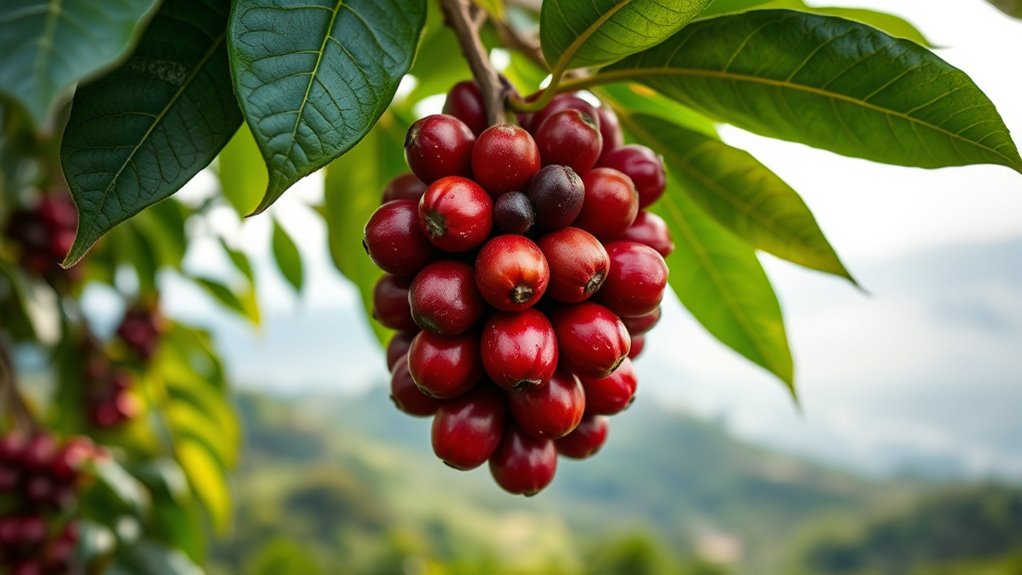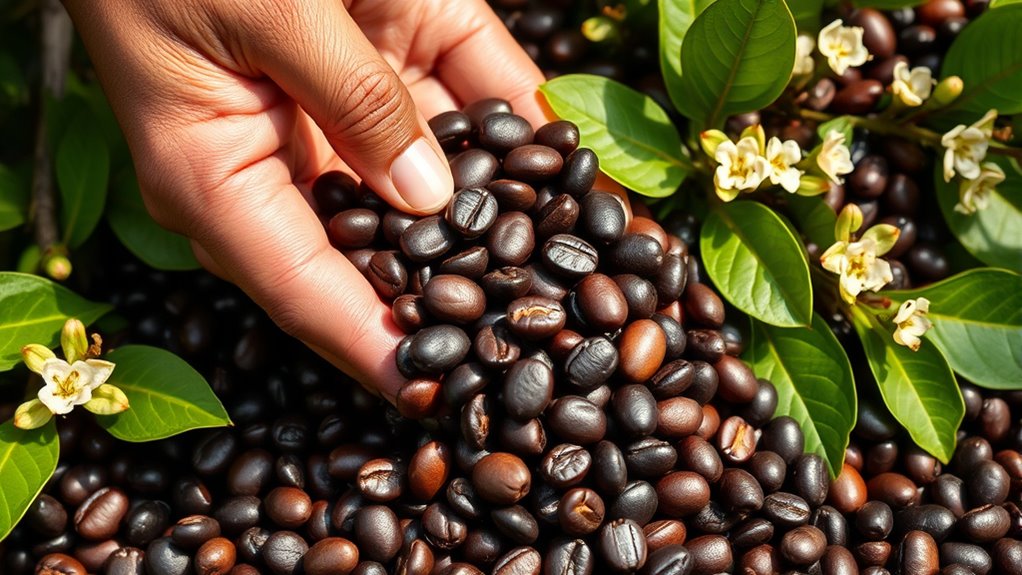Colombian coffee is famous because of its perfect combination of climate, soil, and sustainable farming practices, which create exceptional beans. Farmers use shade-grown methods and focus on environmental care, ensuring high-quality harvests. Expert roasting enhances the natural fruity and floral flavors, resulting in a smooth, vibrant cup. This unique process reflects generations of dedication, making Colombian coffee truly special. To discover how these factors influence each sip, keep exploring the rich world behind Colombian coffee.
Key Takeaways
- Colombia’s ideal climate and rich soil create perfect conditions for high-quality coffee cultivation.
- Sustainable farming practices preserve biodiversity and soil health, enhancing bean flavor and environmental resilience.
- Shade-grown methods protect ecosystems, supporting biodiversity and ensuring ethical water and labor practices.
- Advanced roasting techniques highlight natural flavors, resulting in a vibrant, well-balanced, and complex coffee profile.
- Generations of dedicated farmers and roasters produce a culturally significant coffee known for its smooth, fruity, and floral notes.

Have you ever wondered what makes Colombian coffee so renowned worldwide? The answer lies not only in the country’s ideal climate and rich soil but also in the meticulous approach to sustainable farming and expert coffee roasting techniques. Colombia’s coffee farmers prioritize sustainable farming practices, which means they focus on preserving the environment while producing high-quality beans. They often use shade-grown methods, which protect biodiversity and help maintain soil health. This careful balance ensures that coffee cultivation doesn’t deplete resources or harm local ecosystems, allowing future generations to enjoy the same fertile land. Sustainable farming also involves responsible water use, minimizing chemical inputs, and supporting fair labor practices. These efforts guarantee that the beans are cultivated ethically and sustainably, which adds to their exceptional flavor and quality. sustainable farming practices play a crucial role in maintaining the high standards and reputation of Colombian coffee. Additionally, the emphasis on environmental stewardship enhances the beans’ unique flavor profile and supports the local economy.
Once the beans are harvested, the art of coffee roasting takes center stage. Colombian roasters employ advanced coffee roasting techniques that highlight the beans’ natural flavors. They carefully control temperature and time, allowing the beans to develop a rich aroma and a balanced taste profile. This precision roasting process is essential for revealing the beans’ full potential, capturing the subtle fruity and floral notes characteristic of Colombian coffee. Skilled roasters often experiment with different roasting profiles, from light to dark, to suit various preferences while maintaining the beans’ integrity. The combination of careful roasting and high-quality beans results in a vibrant cup that’s smooth, well-rounded, and full of complexity.
The harmony between sustainable farming and expert roasting techniques is what truly distinguishes Colombian coffee. It’s a deliberate process that respects nature, supports local communities, and celebrates the unique flavor characteristics that make Colombian beans so sought after. Every step—from planting and harvesting to roasting—is performed with care and expertise, guaranteeing that each cup delivers an authentic taste experience. When you sip Colombian coffee, you’re tasting the result of generations of farmers and roasters committed to quality and sustainability. This dedication creates a coffee that’s not just enjoyable but also responsible and rooted in tradition. That’s why Colombian coffee continues to earn its reputation as one of the finest coffees in the world.
Frequently Asked Questions
What Are Colombia’S Main Coffee-Growing Regions?
You’ll find Colombia’s main coffee-growing regions mainly in the Coffee Triangle, including Antioquia, Caldas, Quindío, and Risaralda. These areas are known for their lush coffee plantations, where the harvest season typically runs from April to December. During this time, you can witness the vibrant coffee farms and learn how farmers carefully harvest ripe beans, ensuring the high quality that makes Colombian coffee so renowned worldwide.
How Does Altitude Affect Colombian Coffee Flavor?
Altitude effects markedly influence Colombian coffee’s flavor profile. As you grow beans at higher elevations, the cooler temperatures slow the ripening process, resulting in more complex and vibrant flavors. You’ll notice brighter acidity and nuanced aromas, which are hallmarks of high-altitude coffee. Lower altitudes produce beans with a fuller body and milder acidity. So, your coffee’s altitude directly shapes its unique taste, making Colombian beans highly sought after worldwide.
What Sustainable Practices Are Used in Colombia’S Coffee Industry?
Imagine sipping coffee that’s gentle on the planet. In Colombia, farmers embrace sustainable farming practices, conserving water and reducing chemical use. They often pursue eco-friendly certifications, ensuring their methods protect the environment and support local communities. By blending tradition with innovation, Colombian coffee producers maintain high quality while honoring nature. This commitment helps keep the country’s coffee industry vibrant, responsible, and rewarding for everyone involved—from farmers to drinkers like you.
How Is Colombian Coffee Graded and Certified?
You’ll find Colombian coffee undergoes strict grading standards, evaluating factors like bean size, density, and defect count. Coffee certification ensures quality and sustainability, with options like Fair Trade and Rainforest Alliance verifying ethical practices. These processes help maintain high standards, making Colombian beans highly sought after worldwide. By adhering to grading standards and obtaining certifications, Colombia guarantees premium quality coffee that meets both consumer expectations and ethical benchmarks.
What Are the Popular Colombian Coffee Brewing Methods?
You can brew Colombian coffee in many ways, from traditional drip coffee to espresso, highlighting its versatility. Cold brew offers a smooth, crisp, revitalizing option, while careful coffee roasting enhances its rich flavors. You might also enjoy pour-over or French press methods, which bring out Colombian beans’ unique aroma and taste. Experimenting with these techniques lets you savor the beans’ full potential, giving you a personalized coffee experience every time.
Conclusion
Now that you know what makes Colombian coffee so exceptional, you might think you’ve seen it all. But there’s more beneath the surface—secrets in the highlands, hidden flavors waiting to surprise you, and stories rooted in tradition that haven’t been told yet. The next cup could hold an unexpected twist, a taste you never anticipated. So, will you explore further and uncover what truly makes Colombia’s beans legendary? The journey’s just beginning.









